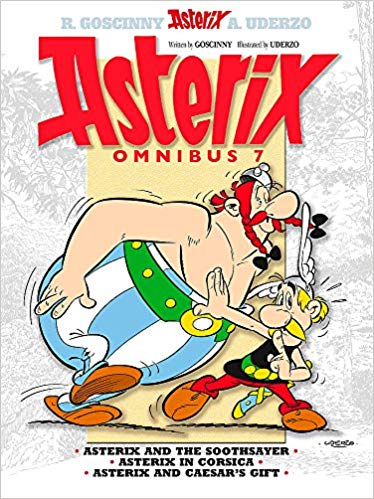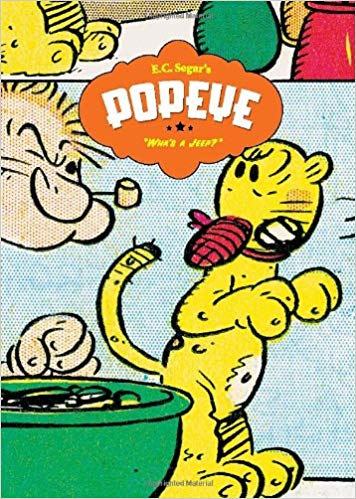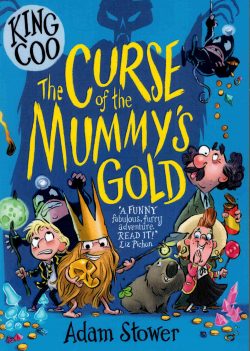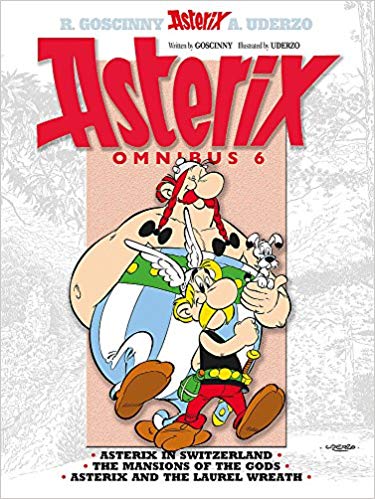
By Goscinny & Uderzo, translated by Anthea Bell & Derek Hockridge (Orion Books)
ISBN: 978-1-44400-835-7 (HB), 978-1-44400-836-4 (PB)
One of the most-read comics strips in the world, the collected chronicles of Asterix the Gaul have been translated into more than 100 languages since his debut in 1959, with animated and live-action movies, TV series, assorted games, toys and even a theme park outside Paris (Parc Astérix, unsurprisingly…) all stemming from his glorious exploits.
More than 325 million copies of Asterix’s many albums have sold worldwide, making his joint creators France’s bestselling international authors.
The doughty, potion-powered paragon of Gallic Insouciance was created by two grandmasters of comics: Ren̩ Goscinny & Albert Uderzo. Although their inspirational collaborations ended with the death of the prolific scripter in 1977, the creative wonderment continued until relatively recently from Uderzo, assistants and ultimately his successors Рalbeit at a slightly reduced rate.
The wonderment works on multiple levels: ostensibly, younger readers revel in action-packed, lavishly illustrated comedic romps wherein sneaky, bullying baddies get their just deserts, whilst we more worldly readers enthuse over the dry, pun-filled, sly satire, especially as enhanced for English speakers by the brilliantly light touch of translators Anthea Bell & Derek Hockridge, who played no small part in making the indomitable Gaul and his gallant companions so palatable to the Anglo-Saxon world.
(Moi, I still rejoice in a perfectly produced “Paf!†to the phizzog as much as any painfully potent procession of puns or sardonic satirical sideswipe…)
The stories were set on Uderzo’s beloved Brittany coast, where a small village of warriors and their families resisted every effort of the Roman Empire to complete the conquest of Gaul, or alternately, anywhere in the Ancient World, circa 50 BCE, as the Gallic Gentlemen wandered the multifarious provinces of the Empire and even beyond its generally-secure borders…
When the heroes were playing at home, the Romans, unable to defeat this last bastion of Gallic insouciance, resorted to a policy of containment. Thus, the little seaside hamlet is permanently hemmed in by the heavily fortified garrisons of Totorum, Aquarium, Laudanum and Compendium.
The truculent Gauls don’t care: they daily defy the world’s greatest military machine simply by going about their everyday affairs, protected by the magic potion of resident druid Getafix and the shrewd wits of the diminutive dynamo and his simplistic, supercharged best friend…
Firmly established as a global brand and premium French export by the mid-1960s, Asterix the Gaul continued to grow in quality as Goscinny & Uderzo toiled ever onward, crafting further fabulous sagas; building a stunning legacy of graphic excellence and storytelling gold.
Le Devin was the 19th serialised epic, originally running in Pilote #652-673 throughout 1972, first translated into English album Asterix and the Soothsayer in 1975, and begins ominously whilst the village’s venerable mystic protector Getafix is away at his annual Druiding conference.
During a torrential storm, a nefarious soothsayer named Prolix turns up seeking shelter. His dark predictions instantly spread disharmony amongst the hospitable, hot-headed, painfully superstitious and credulous Gaulish stalwarts… except for level-headed, canny little Asterix.
As Prolix leaves, Chief’s wife Impedimenta sneaks after him, keen on a personal prediction, and the crafty charlatan soon discovers he’s on to a good thing and profitably cushy number…
Before long the entire village is under the soothsayer’s grimy thumb, but when he vanishes the ladies of the village accuse Asterix of driving him away.
In actuality, the unsavoury sage has been arrested by the Romans who have standing orders to deal harshly with all non-Roman prognosticators and troublemakers. Wily Prolix barters for his life with Centurion Arteriosclerosus, who sees a way to end his Indomitable Gaul problem by using the obviously fraudulent fortune-teller as a wedge to drive out the obstreperous resistors. Prolix returns to the village uttering a doom-laden pronouncement: the place has been cursed by the Gods and a pestilential stench will precede plague. Inevitable death will be their fate if they remain…
Panicked, the gullible Gauls head for the beach and take refuge on an off-shore island – all that is, except for Asterix, Obelix and chivalrous canine companion Dogmatix…
With the Romans at last in possession of the village – and all Gaul finally conquered – the bold last rebels make their plans until Getafix returns. On his arrival the three men and a dog embark on an elaborate scheme to take back their home and teach their foolish fellows a much-needed lesson.
Concocting a stunningly malodorous vapour which drives the occupiers from the village, the druid convinces the Romans that Prolix is a real soothsayer and ambitious Arteriosclerosus sees a chance to become the next Caesar. Increasingly baffled, conman Prolix begins to believe his predictions are real…
After dressing down the refugee Gauls, Getafix leads them back to their beloved homes where the incensed and wiser villagers top up on magic potion before rushing off to teach the invaders – and Prolix – a much needed lesson. On this occasion, Impedimenta and the village women accompany their men, determined to expiate their embarrassing gullibility with a little cathartic violence of their own…
This delightfully arch and acerbic attack on gullibility and superstition is a splendid and long-overdue chance to see the minor characters play to their strengths and weaknesses, with Asterix and Obelix almost relegated to walk-on parts…
First translated two years earlier in England but chronologically following on from The Soothsayer in the original French serialisations, Astérix en Corse (Pilote #687-708, in 1973) was the 20th adventure and the best-selling French-language album of the series.
Another globe-trotting yarn, it begins with the Romans of the four occupying garrisons “deploying for manoeuvres†to avoid having to deal with Gauls’ painfully exuberant celebration of the anniversary of the Battle of Gergovia. Unfortunately for Centurion Hippotamus and his men, they are delayed by the arrival of a party from Praetor Perfidius, Governor of Corsica, escorting a dangerous prisoner into exile. They are all still in Totorum when the high-spirited villagers (and many guest-star friends from previous tales) arrive, keen for a punch-up and a little annoyed that all the other Roman camps are deserted…
When the dust settles and the groans of pain subside, Asterix discovers and liberates the prisoner Boneywasawarriorwayayix and invites him back to the village for a slap-up feed. Over boar and beer, the Gauls hear how Perfidius had the popular Corsican leader exiled to prevent him revealing how the Praetor has been over-taxing the people and embezzling the gold for himself instead of sending it to Caesar in Rome.
Corsica is officially the most troublesome spot in the Empire and the exile is determined to return and expose the hated Governor, so proud, haughty Boneywasawarriorwayayix is delighted when Asterix and Obelix – with faithful canine companion Dogmatix – determine to help him sneak back to his fiercely over-fortified and contained island (most volumes of this album have a map of Corsica instead of the traditional Gaulish village, and the tiny nation contains four towns and forty-six Roman camps)…
Hilariously obtaining passage on the pirate ship of Redbeard, the voyagers soon find themselves on the island – but by no means unnoticed…
Soon the dissolute and lazy soldiery are hunting the heroes as they make their way inland to the exile’s home village to rally the populace, whilst in the city of Aleria Perfidius reckons the jig is up and prepares to flee with his ill-gotten gains…
Attempting to rally the natives, Boneywasawarriorwayayix comes up against the age-old dilemma: most Corsicans are involved in centuries-long vendettas and would much rather fight each other – at least when they’re not taking a siesta – than unite to attack the invaders. However, eventually – and almost too late – a determined band of warriors march on Aleria. Perfidius has been secretly loading his loot onto a ship, but when his soldiers discover the riches, they realise their leader is planning to abandon them to the fiercely furious Corsicans – at least if overtaxed diplomatic Asterix can keep the natives from killing each other first…
Asterix travel epics are always packed with captivating historical titbits, soupcons of healthy cynicism, singularly surreal situations and amazingly addictive but generally consequence-free action, always illustrated in a magically enticing manner.
Stuffed with sly pokes and good-natured trans-national teasing of perceived (and generally treasured) national characteristics; celebrating the terrifying power of Corsican cheeses and liberally served up with raucous hi-jinks and fast-paced action, this is another magical titbit of all-ages entertainment.
In 1974 Le Cadeau de César was the first tale to be published as a complete album prior to being serialised, with British translation Asterix and Caesar’s Gift appearing in 1977. The saga begins in Rome where two 20-year veteran legionaries drunkenly celebrate being honourably discharged. Tremensdelirious and Egganlettus eagerly look forward to being given their service reward: a parcel of land each.
Unfortunately, Tremensdelirious is overheard disparaging Caesar, but the sardonically cruel Emperor does not punish the old soldier or even withhold his pension. In fact, he gives the veteran a lovely portion of the Gaulish coast in Armorica: all he has to do is shift a few recalcitrant Gauls from their village on his new small holding…
A drunk but not a fool, the old soldier knows his fate is sealed and soon trades his dispensation to Lutetian inn-keeper Orthopaedix to settle his outstanding and prodigious bar-bill…
The first that the Indomitable Gauls know of this is when Orthopaedix, wife Angina and daughter Influenza roll up in their cart and try to take possession. After some hilarity the villagers go back about their business and the inn-keeper is left to suffer the fury of his wife at the uprooting of the family to a barbaric hovel where nobody acknowledges their claim.
No stranger to such a tongue-lashing, Chief Vitalstatistix takes pity on Orthopaedix, offering to let them stay and open an inn in the hamlet, but the standoffish villagers are angered by Angina’s superior airs and a riot breaks out on opening night…
The world-weary publican is ready to quit, but now humiliated Angina is in a status duel with Impedimenta and, determined to stay, forces Orthopaedix to challenge Vitalstatistix for the post of village Chief. As the campaign to win the support of the always-argumentative villagers intensifies, all manner of shoddy tactics, dubious lobbying and outright bribery takes place, with each party frantically trying to curry political favour from the fickle but extremely astute potential voters who know the value of their own support…
Meanwhile, simple, gentle, oafish Obelix has fallen under the spell of the lovely Influenza, and she leads him on cruelly to help out her mother’s naked ambition, leading to a clash with his best friend. Only Asterix seems aware that the discord could well be the death of the village and lead to Caesar’s ultimate triumph and before long the waters are further muddied when elderly Lothario Geriatrix declares himself a third party, splitting the potential vote even further.
The political crisis reaches boiling point when Tremensdelirious turns up, demanding his land-grant back: after all it’s illegal to sell them to Gauls, and Orthopaedix has no say in the matter…
When the ex-legionary turns violent, Asterix steps in to save the day and the old sot is driven off at sword-point. He doesn’t go far – only to the garrison of Laudanum where old comrade Egganlettus has re-enlisted – and together they blackmail Centurion Tonsillitus into attacking the Gauls to uphold Roman law and get back that “official†pension land which is every soldier’s right…
That kind of military intervention usually ends disastrously, but this time the village is hopelessly divided by political intrigue and backstabbing and even Asterix cannot unite them against their real and common foe. It seems that the Gauls must lose everything until Orthopaedix makes a supreme sacrifice to save the day…
Brittle, barbed and devilishly sharp, this outrageous political thriller and satire on modern electioneering is as pertinent and punchy as it ever was, proving once again that these Gallic graphic masterpieces are perfect comics which everyone should read over and over again.
© 1972-1974 Goscinny/Uderzo. Revised English translation © 2004 Hachette. All rights reserved.



















